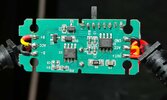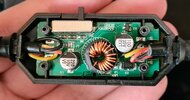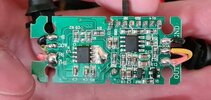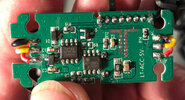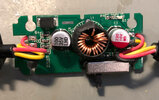...but still it was "designed" for a battery (so no wonder that "ripple filtering is poor")
Not trying to be smart here, genuine question.
You do realise that the HK3 is the source of the ripple right?
So regardless of power supply it will be there.
The amount will vary based on input voltage and load.
I tested this before and basically the whole system works at <=3.3V so as (could be) expected A129Pro works even at 3.3V via USB
Ok, i've not tested this but common electrical engineering sense says this is impossible.
There is a thing called 'dropout' with regard to regulators. Basically the voltage has to be a particular amount above the output or the regulator 'drops out'.
For a real example, the Texas Instruments 1117A 3.3v regulator has a dropout voltage of 1.3V max with a 1A load.
This means that for the 3.3v regulation to be maintained the incoming voltage needs to be 3.3v plus the dropout voltage (1.3V) for proper operation.
That means the input voltage needs to be maintained above 3.3+1.3=4.6 volts.
-source
https://www.ti.com/lit/gpn/REG1117
The camera probably doesn't use the 1117 (well it might, i don't have one here at the moment) but it will use something with similar qualities.
Theory dictates that unless the input of the camera has a buck/boost regulator it will not operate with a 3.3v input, and stands a good chance of being unreliable under about 4.6v depending on the reg it does employ.
(<3.5V LCD flickers, <3.3V starts to shuting down in 2CH/<3.1V starts to shuting down in 1CH) that was the reason i wasn't buying that whole "lamp cable" solution of yours (more like another HWK Vpp overshoot issue or a cable issue, and the capacity or a better connection of the lamp cable saved the day)
The issue i suspect is actually under voltage, but you have some interesting findings there.
You'll have to pardon me for being skeptical until they are backed by another source.
Also in fairness, people should be sceptical of my findings also until they have been verified.
It's how science works.
I can see a possible variance from batch to batch, both of HWK's and cams both, where individual pairing could lead to problems or not. In that kind of 'marginal' situation, a switch to lamp cord for lower resistance could make just enough difference to cause the stated results for that one situation.
We like to see performance and specs as solid numbers, but in everything electronic there is some variability, which is why component tolerance is mentioned in schematics where a out-of-tolerance component might cause erroneous results. I think we all can agree that in these two units which have been put to the 'scope, the resulting ripple found is very excessive. So now I think it needs to be found whether this problem is widespread and if so, then how many are like this.
These are all built cheap so we will not possibly get the best from them, but they should be reasonably good by design and there should be enough QC to ensure that defective units do not become common in the hands of buyers.
More testing is needed throughout a wide range of production times to know for sure what is going on here. Only then can we properly analyze the test results to give a complete and accurate view.
Phil
This person knows it.
You've described the situation completely as I understand it.
I don't think these 'faulty' units are 'faulty' at all. I think they are all bad, and the combination of a low tolerance input on the camera, combined with a slightly poorer than average couple of regs has lead to this.
This is exactly why i want to test more units. I suspect they all have rotten regulation, as even a cursory glance at the crude circuit reveals.
I suspect that as new models of cameras came along with higher power requirements this was bound to hit a tripping point.
I suspect the 'failure' rate on these is very low....... until you power a 1amp camera with them, and even though they still might mostly work, i think the percentage of HK3's not working when used in conjunction with an A129 will be more significant.
This is the underlying reason i test at both 500mA and 1A, as the result is different with different loads.
Keen to do more testing, don't have the cash to 'self fund' this research, but happy to test on anything anyone will send me.
If it means enough to some people i'd consider accepting cash donations, but i'd have to become comfortable with the idea.
I am not a formally trained electronics engineer, so i'd want people to consider that first.
Just being objective based on the glance of the circuit in the HK3 i think it is wide spread, and possibly not limited the the HK3.
If i were a product manager or engineer or something i'd be testing my brands units in house.
A possible compromise could be to only supply this regulator for use with low power cameras and commission a new design for higher power cameras.
That should nip the initial issue in the bud, and once these are all phased out move across to the better regulator for all devices.
I'm sure many of these units are having issues that are being experience by people not using forums like this, and thos issues are possibly not making it up the chain to the manufacturers.
Not sure what a lamp cord is..., can anyone fill me in? Hope i'm not missing something obvious.. Just a different kind of USB cable?
On the subject of cords, the gauge of wire, both negative and positive will play a large part.
My first test was at the output of the regulator, on the regulator PCB, and showed a low of 4.52v .
Testing again with the cord in the equation showed the dashcam would have actually seen a low of 4.12, 400mV less that the voltage measured at the PCB.
If I cut this cord to be 6 inches (150mm) long I suspect it may power the A129 with no apparent issues.


